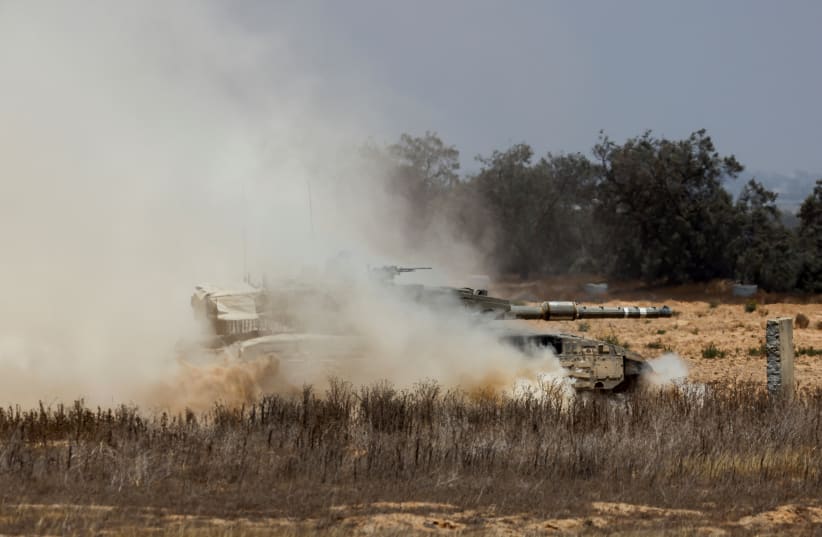The battlefield requires constant monitoring, and learning about the enemy – two elements that Israel’s technology excels at.
By SETH J. FRANTZMAN
MAY 30, 2024 14:53
Updated: MAY 30, 2024 21:20
An Israeli tank maneuvers, amid the ongoing conflict in Gaza, in southern Israel, May 30, 2024
(photo credit: REUTERS/AMIR COHEN)
Earlier this week, it was reported that the IDF has been using new unmanned M113 APCs in Gaza. The tracked vehicles are old, dating from the 1960s, but they have been repurposed to be used without people.
“Unmanned” is now the name of the game in future warfare. Usually, these types of systems are called drones, especially when they fly. In contrast to the old M113s, which got a new lease on life through tech integration, a plethora of drones is redefining how the IDF is changing during this war.
The Israel Defense Forces has also created a number of new drone units in the last few years. In April, for instance, the IDF said it had created a new squadron for the Hermes 900 drones. Squadron 147 was supplied with the large drones and is based on Palmachim, the base on the coast of Israel that is also home to the Hermes 450 ‘Zik’ squadron. The Hermes 900 is a large, advanced drone that can fly at medium and high altitudes for a long period of time and conduct surveillance over a large area. A second Hermes 900 squadron, the 166th, already exists at Palmachim.
State of the art
The IDF also reopened the 144th squadron as a drone unit flying the Spark UAV, a drone that is between a small- and medium-sized platform, developed by Aeronautics.Hermes 900 UAV (credit: ELBIT SYSTEMS)
The war has also seen the increased use of different types of drones and loitering munitions. Israel had already pioneered the use of drones and artificial intelligence, but this war has facilitated the addition of new technologies to enhance the deployment of multiple drone layers on the battlefield. This means that larger drones with strike capabilities, such as the Hermes 450, are used with smaller drones, like the Skylark, which help artillery spotters. In addition, ground forces have access to smaller drones. In fact, over the last year, the IDF has created several new units specifically for the use of drones. Units such as the IDF’s Ghost Unit, which uses new technology, use smaller drones. In addition, some units have acquired quadcopter drones, similar to commercially available types.
Other systems, like Elbit Systems’ Magni-X quadcopter, also enhance Short Range Reconnaissance and support combat and intelligence operations. The quadcopter is a vertical-takeoff-and landing micro-UAS that can be carried in a backpack and can be in the air for up to 60 minutes at a time. Like the Magni-X, Elbit’s Thor mini-UAS is a military tactical fully autonomous mule platform designed for a wide range of military applications, including reconnaissance in dense urban areas.
The IDF also developed a weapon called the Maoz, or Spike Firefly, which is a loitering munition. It functions like a drone, with a propeller on top of a long tube. It can then be lifted off, and the operator can decide whether to use it to strike a target. Ideal for fighting in an urban environment, it makes it possible to strike enemies who might be hiding behind walls or alleys. The Spike FireFly was created by Rafael Advanced Defense Systems. Rafael, Maf’at, and the Defense Ministry have successfully completed an experiment in the Rafael-made SPYDER All -in-one air-defense system. January 10, 2024. (credit: DEFENSE MINISTRY)
The use of new drone technology and flooding the zone with numerous types of drones at all levels of combat provide the troops with a lot more security on the battlefield. This means that there are often multiple layers of drones over Gaza, which can provide the IDF with all the layers of resources it needs. There are drones that can help artillery direct their fire more precisely, and others can keep overwatch of an infantry or tank unit that is carrying out a maneuver in an urban area. Units in the urban area can also use drones at the tactical level to see around corners or inside buildings. When necessary, some types of drones can also carry out strikes on enemies.
At the end of the day, the battle against the enemy in Gaza is the same battle that has gone on for decades against enemies in Gaza. The enemy changes somewhat – they use tunnels, have access to more RPGs and anti-tank missiles, and pop out of buildings dressed as civilians to take shots at the IDF. Drones can help by following the threat as it weaves its way between buildings, or they can help distinguish between threats and civilians. In a complex battle space like Gaza, this is critical. The drones can also help connect the ground forces with the air force and other fire support units, such as the navy or artillery.
In the old days, a ground force, such as a battalion or a company of tanks and infantry, would take time to be able to call in fire support. Now, everything is about being faster, more precise, more efficient, and saving lives. Drones help close the loop and provide real-time information with the latest, most advanced sensors, which can track movement or use artificial intelligence to help distinguish enemies. In Gaza, troops must be able to respond quickly, with enemies using RPGs before running away. The battlefield requires constant monitoring, and Israel’s new technology is key to that.
OTHER TYPES of technology have also been in the spotlight during the war. The IDF used its new Sa’ar 6 corvettes in combat for the first time. The new ships, of which there are four, use a new type of radar and an improved 76 mm. gun. They also used the new precision mortar system, known as the Iron Sting, for the first time. The precision mortar is a 120-mm. mortar that can be mounted on a Humvee, an M113, or other platforms. The mortar is slightly longer than a traditional mortar, and it has fins that enable it to precisely strike a target. It weighs 17 kilograms and has a range of around six miles. The precision mortar is made by Israel’s Elbit Systems.
This war has also revolutionized Israel’s air defenses. The Arrow 2 and Arrow 3 systems, which defend against ballistic missiles, had their first interceptions. These have been key to protecting Eilat from Houthi missile threats, as well as defending the country against the Iranian ballistic missile threat on April 13–14. The Arrow, made by Israel Aerospace Industries, was developed jointly by Israel and the US over the last decades.
The naval version of Iron Dome, known as C-Dome, was also used for the first time in this war – in the Red Sea, off the coast of Eilat – to take out a drone threat. The David’s Sling system, used frequently, received an Israel Defense Prize for its success.
Another system that came into use during the war was the new shoulder-launched missiles, acquired from the US. Dubbed the Holit and Yated, after two Israeli communities near the Gaza border, they are larger than other shoulder-launched missiles that the IDF has used over the years. The IDF also introduced an improved version of the Negev machine gun, new night vision goggles, and the SmartShooter sight for rifles to help take down drones.
All this new technology is designed to make fighting more precise and to provide operators with more information. It also expands the realms in which the IDF operates, including a new space directorate and improving the evacuation time of the wounded by helicopter. This is only the beginning of the innovations from the current war in Gaza. Almost eight months of war have brought a myriad of new technologies to the front, and more systems, from rocket launchers to artillery, will continue to be rolled out.
>>> Read full article>>>
Copyright for syndicated content belongs to the linked Source : The Jerusalem Post – https://www.jpost.com/israel-hamas-war/article-804380
































Why Labeling Politics as ‘Dirty’ Is a Dangerous Misstep That Harms Us All